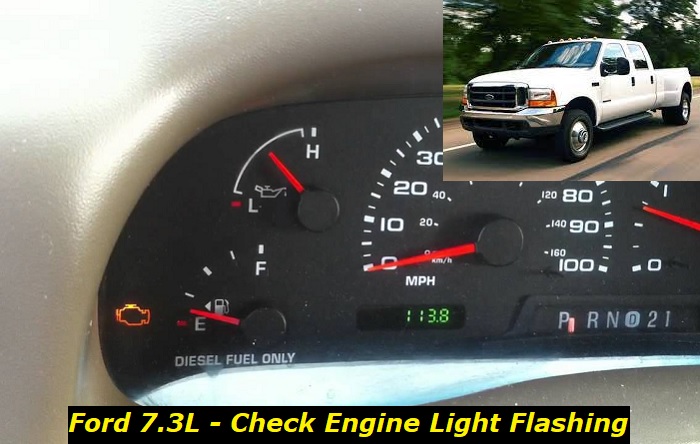Have you ever been out on the road and noticed the check engine light in your Ford 7.3L was on? Perhaps you decided to ignore it and felt a slight bit of relief when the light disappeared a while later. You probably felt more confusion when it lit up again a short while later. The check engine light coming on and off is a confusing and potentially concerning experience, especially if you're not sure what might be causing the issue.
The timing of the check engine light could be unpredictable. It could stay on after a few instances of starting the engine, or it might disappear the next time the engine is started. It may stay off for a few hours, or days, or it might even stay off as long as a few weeks. The good news is that this problem is typically caused by minor issues. However, these issues need to be addressed on time to prevent them from developing into serious problems.

There are several common reasons why the check engine light might come on and off in a Ford 7.3L engine. By understanding the issues that can trigger the check engine light, you can take the necessary steps to keep your vehicle running smoothly and avoid any further problems down the road.
Reasons Your Check Engine Light Comes On and Off
The check engine light coming on and off is a sign of an intermittent problem. This doesn't mean that the problem has gone away permanently, just that it reappears after disappearing. This usually indicates a minor problem with the potential to build into a more serious condition, so it is important to find the cause of the problem and resolve it quickly.
There are many reasons the check engine light could come on, but if it is coming on and off, then the list is easier to narrow down. Here are some of the major reasons why your check engine light could be turning off and on.
- Gas Cap isn't On Securely
When the gas cap isn't tightened adequately, it can cause small amounts of fuel to evaporate from the fuel tanks. The engine detects this as a leak from the EVAP system and might illuminate the check engine light as a result.
While this isn't a serious problem, and it is easy enough to address, it can result in decreased fuel efficiency from fuel wastage. Your money could be evaporating out of your fuel tank.
- Cam Position Sensor
This is one of the most common problems with the Ford 7.3. Many of these vehicles are equipped with faulty cam position sensors that are vulnerable to failure when driving over rough or bumpy roads. A faulty cam position sensor can result in the check engine light coming on. It will also result in the engine cutting out whenever this issue is detected.
- Faulty Glow plug
When a glow plug is reaching the end of its life or is about to go bad, it might fail to heat up to the right temperature for diesel combustion. This causes occasional misfires that the ECU will notice and report with the check engine light. The glo wplug might continue to work well for a few engine cycles, and the ECU will remove the check engine light warning.
Dirty glowplugs can also cause occasional misfires, especially if they aren't dirty enough yet to completely render the plug ineffective.
Addressing faulty glowplugs on time is crucial, as they can cause misfiring that can lead to engine damage. Ignoring this issue can result in costly repairs and potentially jeopardize the overall performance and safety of your vehicle.
- Faulty Under Valve Cover Harness (UVCH) Wiring
The glowplugs in the 7.3 engine receive the electrical energy they need through the under valve cover wiring harness. Any problems with the wiring in the harness can result in the glowplugs or fuel injectors not receiving enough energy to function. This can result in misfires and an illuminated check engine light.
A commonly reported issue with Ford 7.3 engines is that the valve cover wears down or chafes the insulation on the wires of the under valve cover wiring harness. This can cause occasional shorting out of the wires. When the shorting out doesn't occur continuously, it can cause the check engine light to come on for a while and disappear again.
Another common problem with the UVCH in these engines is that the wiring connector tends to come loose or even melt. A loose connector can cause intermittent engine light warnings as it shifts between positions where it is well connected and poorly connected.
What Can You Do About It?
Many car owners are used to ignoring the check engine light whenever it comes on. Even if the car is still driving well with no noticeable problems, this is not recommended. The check engine light could be indicating a minor issue that will slowly develop into a bigger problem in the future, especially if you notice the light stays on for longer, or if the light spends less time off. The check engine light coming on could also mask other more serious problems with the engine.
Because there are so many things that could be wrong with the car to cause this problem, you will need to diagnose the issue before you can fix it. You can identify the general source of the problem by scanning the car with a diagnostic trouble code scanner. Make sure to check for any recent codes as well. Once you have the trouble codes, you can search the codes online to find out which system in the car is the source of the problem.
1) Check the Fuel Cap
Examine whether the fuel cap is closed properly. If the fuel cap is not on properly or is not closed tight, then you will need to tighten it.
Make sure to examine the integrity of the fuel cap as well. If it is damaged, it might not be able to form a perfect seal anymore. This could create a small leak in the EVAP system that causes the check engine light to come on.
2) Check the Cam Position Sensor
If you've experienced your car stalling after hitting a bump or a rough patch of road, then you are most likely dealing with a defective cam position sensor.
The issue can be solved by removing the faulty sensor from your vehicle and replacing it with the updated version that addresses the issue.
3) Examine the Glow plugs
Glow plugs are an important part of a diesel engine and ensuring that they are in good condition will keep the engine running as smoothly as possible. If you suspect the glow plugs are the source of the problem, then you will need to inspect them to find out if they need to be cleaned or replaced.
To check whether the glow plugs are in good condition, remove them from the engine and visually examine them for grit and signs of carbon deposits. If the plugs are dirty, you can clean them with brake cleaner and a wire brush. However, replacing dirty glowplugs with new ones will improve the performance of the engine.
If the glowplugs are old or starting to fail, then you will need to replace them with an appropriate replacement.
4) Examine the Under Valve Cover Wiring Harness
Examine the under valve cover wiring harness for signs of physical damage. Make sure to check all the points where the weight of the valve cover rests on the harness. Look for signs of broken insulation and pinched wiring.
You should also examine the wiring for a loose UVCH connector. Unplug the UVCH connector and examine both sides for signs of burning or melting.
If you identify any damage to the wiring, then you will need to replace the under valve cover wiring harness with an appropriate replacement.
If none of the above methods have helped to rectify the problem, then you might need to take the car to an automotive professional. They will use an OBD2 scanner to identify any problems with the vehicle that could be causing the check engine light to come on.
Conclusion
Most drivers choose to ignore check engine lights, especially when they go away on their own. If the light comes back on and then goes off again after a while, you'll need to pay attention. This is a sign of an intermittent engine problem that could develop into something serious over time.
A recurring check engine light could be caused by something as small as a loose fuel cap cover, or it could be the result of a deeper problem, like a damaged under valve cover harness. A quick diagnostic scan of your vehicle will show you the codes stored in its recent history and should give you a good idea of where to start looking.
Depending on the problem, you might just need to tighten the gas cap or replace the glowplugs. You might also find yourself needing to replace the UVCH. Whatever the problem is, prompt action might be the thing that saves you from eventually having to deal with a misfiring engine or worse.
About the authors
The CarAraC research team is composed of seasoned auto mechanics and automotive industry professionals, including individuals with advanced degrees and certifications in their field. Our team members boast prestigious credentials, reflecting their extensive knowledge and skills. These qualifications include: IMI: Institute of the Motor Industry, ASE-Certified Master Automobile Technicians; Coventry University, Graduate of MA in Automotive Journalism; Politecnico di Torino, Italy, MS Automotive Engineering; Ss. Cyril and Methodius University in Skopje, Mechanical University in Skopje; TOC Automotive College; DHA Suffa University, Department of Mechanical Engineering






Add comment